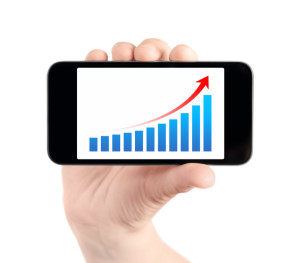by gabriel_sales | Jul 11, 2014
 B2B companies are always looking for ways to sell more and better. This year, it looks as through B2B companies may be trying to tap into a marketing strategy that has so far been dominated by B2C: mobile.
B2B companies are always looking for ways to sell more and better. This year, it looks as through B2B companies may be trying to tap into a marketing strategy that has so far been dominated by B2C: mobile.
Mobile in B2B
As early as last fall, marketing studies began finding that “B2B commerce is adopting B2C best practices in order to optimize the purchasing experience.” In terms of mobile, the study found that 75% of respondents planned to offer mobile sometime within the next 12 months.
The study suggested that the motivation for this stems directly from customer demand. This makes sense, as mobile devices become more and more a part of our lives, we increasingly want to be able to use them to learn about consumer products and services, whatever type they may be. In other words, whether we are looking for a new car or management consulting services, we want to be able to do both on our iPad while we are waiting to catch a plane or for our daughter to be done with soccer practice.
More recent data shows B2B companies are taking this demand seriously and investing to meet their customers’ needs. At last month’s Internet Retailer Conference & Exhibition, a study of 100 businesses was done that found:
“Mobile commerce was cited as a top investment area more often by companies involved with B2B e-commerce than by those in retail e-commerce . . . Among those [37] respondents that were solely B2B, 26 cited mobile as one of their top three investment areas, followed by 19 that cited web commerce, 19 social, 10 e-mail marketing, and nine search marketing.”
For more on B2B marketing trends in 2014, you can read this blog series.
by gabriel_sales | Jul 9, 2014
 Many B2B companies today are searching for solutions to generate more leads and are considering marketing automation.
Many B2B companies today are searching for solutions to generate more leads and are considering marketing automation.
For some companies, this has meant venturing into the fast-paced and complex world of B2B content marketing. And while almost any content you produce can’t hurt, simply throwing content on your website and waiting for leads to come in is no longer enough. To succeed and thrive in 2014, you need digital tools that help you manage and streamline your sales and marketing process from start to finish.
One tool that many B2B companies are leveraging with great success is marketing automation. The exact features of these platforms vary somewhat from vendor to vendor, but for the most part, they all help you track and monitor your prospects engagement along various stages of the B2B sales cycle.
In terms of content specifically, here are three ways marketing technologies increases the effectiveness of B2B content marketing.
1. Allows you to track content engagement by prospect.
One of the most beneficial features of marketing automation is the ability to measure content engagement by prospect. With a normal analytics solutions, like Google Analytics or WordPress Stats, you can only see the number of people who clicked on a link or watched a video. With marketing automation, each prospect that visits your site is ‘cookied’, and their subsequent activity and engagement on your site is tracked. This means you will know that it was ‘John S. from ABC Company’ that read your blog, rather than just some anonymous visitor. This type of data allows you to see when specific prospects have shown enough interest to motivate a follow-up email or phone call to move the deal forward.
2. Enables you to keep track of and nurture not-yet-ready-to-buy prospects.
Research has shown that only 5% of B2B prospects are ready to buy at any given time. Many B2B companies today do not have a strategy to deal with the other 95%; they simply discard them as ‘not interested’. However, by nurturing your leads with ‘light’, educational content every once in a while, you can often find new interest (and deals) from leads you generated six months or a year ago. Marketing automation helps you in the nurturing process by giving you a place to track and manage your prospects and their content engagement on an ongoing basis, rather than just campaign by campaign. For example, if a prospect dropped off or ‘went dead’ just before your proposal stage but reengages six months later, you can pick up right where you left off because you have all the data you need in front of you.
3. Allows you to use analytics to refine and improve your content and sales process.
One of the most valuable things marketing automation provides is data. Using the platform’s analytical features, you can track and monitor engagement at a more detailed level in order to understand when and how to improve. For example, some platforms allow you to not only see when a video was watched, but also how long it was watched for. This way, you can see if a lot of your prospects are dropping off at the same place, and know that you need to refine that piece of your message.
For more on how marketing technologies can benefit the B2B sales process, you can read 3 Tips for Success from an Outsourced Marketing Automation Provider. Feel free to contact us with any questions.
by gabriel_sales | Jul 3, 2014
 Last week, we wrote about the state of the marketing automation industry in 2014 and offered some questions for people to ask when considering purchasing a marketing automation software.
Last week, we wrote about the state of the marketing automation industry in 2014 and offered some questions for people to ask when considering purchasing a marketing automation software.
This week, we’ll take a look at a new study from Bizo and Oracle that looks at the value of marketing automation across various tactics in the sales cycle.
The most significant finding from the report was about marketing’s contribution to overall company revenue. The report found that for companies currently using marketing automation software, marketing contributes 20-60% of overall revenue.
This finding suggests that the days of ‘impressions’ and ‘branding’ as measures of marketing effectiveness are over. Using technology, marketing’s contribution can now be tied directly to hard numbers, which means that marketers can now be held more accountable than ever before.
Another key finding from the report has to do with lead nurturing. The report found that 94% of respondents use lead nurturing (taking into account that the respondents from this study were Bizo’s marketing database, “which naturally will over-represent companies currently using marketing technology”). 35% of those engaged in lead nurturing find the practice very important (“we couldn’t live without it”) and 58% find it somewhat important (“we have a few nurturing campaigns running”).
With the rise of lead nurturing and its perceived effectiveness, it would make sense that marketers are looking for ways to improve the effectiveness of their nurturing campaigns. The study from Bizo suggests that one way companies are doing this is by taking a multi-channel approach. CMO of Bizo, David Karel, commented:
“Relying solely on email for lead nurturing is preventing B2B marketers from getting to the next level of business impact. With only five percent of website visitors willingly providing an email address, marketers’ need to find other channels or risk limiting nurturing efforts to a very small portion of their target audience. Multi-channel nurturing represents a massive opportunity to reach prospects beyond the inbox and really boost the return on their marketing spend.”
Read the entire report from Bizo here.
For more on using marketing automation for B2B sales and marketing, you can read 3 Tips for Leveraging B2B Marketing Automation in 2014.
by gabriel_sales | Jul 3, 2014
 The B2B sales and marketing world today is a digital one. In the past decade, nearly all non-digital sales tactics and techniques have greatly declined in effectiveness while their digital replacements have experienced a nearly exponential rise in popularity.
The B2B sales and marketing world today is a digital one. In the past decade, nearly all non-digital sales tactics and techniques have greatly declined in effectiveness while their digital replacements have experienced a nearly exponential rise in popularity.
All of this obviously changed the B2B sales and marketing landscape dramatically. No longer concentrated on tradeshows and industry-related print publications, successful B2B companies today are focused on integrating digital technologies into their sales process for better targeting and increased efficiency.
And while this digital integration and technological expertise is now a requirement for successful B2B sales and marketing, the question remains: is there any merit to keeping some of those older tactics in your toolbox?
Teleservices
When it comes to B2B teleservices, our opinion is yes. While digital tactics and technologies can greatly improve many aspects of your sales process, there are some things that will never be able to be automated and will always require a more traditional, people-oriented approach.
For example, it is fairly easy to generate a lead via inbound digital marketing techniques: someone goes to a search engine, types in a keyword and ends up on your site exploring your content. If you have a marketing automation software that ‘cookies’ your prospects and tracks their content engagement, it is easy to see when a prospect is showing some type of interest.
However, using marketing automation and other web tools, it is not always as easy to figure out just how interested your prospect is and what their real intentions are. Just by watching clicks and page views, you cannot tell if a prospect is desperate to find a solution this week or if it is a competitor trying to ‘borrow’ content ideas.
This is where teleservices can work wonders. When inbound leads come in and show a fair amount of engagement with your marketing content, that is when to have your sales reps call to do some qualifying. As we’ve written about previously, having a sales rep call after a prospect has already shown interest by engaging digitally greatly decreases the ‘coldness’ of the call. The prospect is already somewhat familiar with the company and is generally engaged enough to be open to a discussion at this point.
Read more on this topic here. Feel free to contact us with any questions.
 B2B companies are always looking for ways to sell more and better. This year, it looks as through B2B companies may be trying to tap into a marketing strategy that has so far been dominated by B2C: mobile.
B2B companies are always looking for ways to sell more and better. This year, it looks as through B2B companies may be trying to tap into a marketing strategy that has so far been dominated by B2C: mobile.



